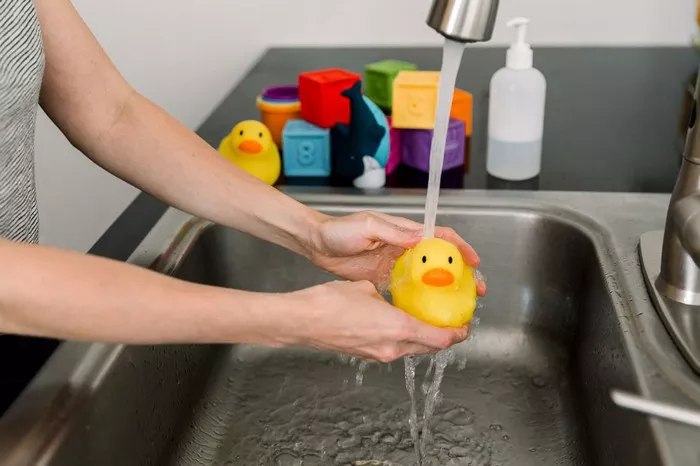As your bundle of joy grows and explores the world around them, their toys become not just sources of entertainment but also objects of discovery and comfort. From soft plushies to interactive electronic gadgets, these playthings play a crucial role in your child’s development. However, with frequent handling and inevitable encounters with spills and drool, these toys can quickly become breeding grounds for germs and bacteria. Therefore, knowing how to properly clean and sanitize infant toys is paramount for maintaining a safe and healthy environment for your little one. In this comprehensive guide, we’ll delve into the importance of cleaning toys, recommended cleaning frequencies, and step-by-step instructions for cleaning various types of infant toys.
Why is Cleaning Toys Important?
The significance of cleaning infant toys cannot be overstated. Young children are particularly susceptible to infections and illnesses due to their developing immune systems and tendency to put objects in their mouths. Toys, being constantly handled and often dropped on the floor, accumulate dirt, germs, and potentially harmful bacteria over time. Regular cleaning helps prevent the spread of illness-causing pathogens and ensures a hygienic environment for your child to play in.
Moreover, clean toys are essential for promoting overall well-being and cognitive development in children. A clean and organized play area fosters a sense of security and comfort, encouraging children to engage in imaginative play and exploration without the distraction of unclean surfaces or unpleasant odors.
How Often Should I Clean My Child’s Toys?
The frequency of toy cleaning depends on factors such as the type of toy, how frequently it’s used, and whether it has been exposed to any contaminants. As a general rule of thumb, plush toys and toys that come into direct contact with your child’s mouth or food should be cleaned more frequently than others.
For everyday toys that see regular use, a weekly cleaning routine is recommended. However, toys that have been visibly soiled or have been in contact with sick individuals should be cleaned immediately to prevent the spread of germs.
How to Clean Plush Toys
Plush toys are beloved companions for many children, but they also tend to accumulate dust, dirt, and allergens over time. Here’s a step-by-step guide to effectively clean plush toys:
1. Read the Care Label: Before cleaning any plush toy, always check the care label for specific instructions from the manufacturer.
2. Surface Cleaning: Start by removing any loose dirt or debris from the surface of the toy by gently brushing or shaking it outdoors.
3. Spot Cleaning: For small stains or spots, use a damp cloth or sponge and a mild detergent to gently dab the affected area. Avoid saturating the toy with water to prevent damage to the fabric.
4. Machine Washing: If the care label permits, machine wash the plush toy on a gentle cycle using a mild detergent. Place the toy in a pillowcase or mesh laundry bag to protect it during the wash cycle.
5. Drying: Air dry the plush toy thoroughly by laying it flat on a clean towel or hanging it in a well-ventilated area away from direct sunlight. Ensure that the toy is completely dry before returning it to your child’s play area.
6. Sanitizing (Optional): To sanitize the plush toy, mist it with a solution of equal parts water and white vinegar or a disinfectant spray suitable for fabrics. Allow the toy to air dry completely before use.
How to Clean Plastic Toys
Plastic toys are durable and easy to clean, making them a popular choice for young children. Follow these steps to keep plastic toys looking their best:
1. Preparation: Before cleaning plastic toys, remove any batteries or electronic components if they are detachable and set them aside.
2. Hand Washing: For small plastic toys or toys with intricate designs, hand wash them in a sink filled with warm water and a mild dish soap. Use a sponge or soft brush to gently scrub the surface of the toys, paying special attention to any crevices where dirt may be trapped.
3. Rinsing: Thoroughly rinse the toys with clean water to remove any soap residue.
4. Sanitizing: To disinfect plastic toys, prepare a solution of warm water and a small amount of bleach (1 tablespoon of bleach per gallon of water). Submerge the toys in the solution for 5-10 minutes, then rinse them thoroughly with clean water.
5. Drying: Allow the plastic toys to air dry completely on a clean towel or drying rack before returning them to your child’s play area.
6. Electronic Toys: For electronic toys, refer to the manufacturer’s instructions for cleaning and maintenance. In general, avoid submerging electronic components in water and use a damp cloth or disinfectant wipes to gently clean the surfaces.
Tips for Cleaning Toys
1. Regular Maintenance: Incorporate toy cleaning into your weekly household cleaning routine to ensure that toys remain clean and safe for your child.
2. Use Non-Toxic Cleaners: Opt for mild, child-safe detergents and disinfectants to minimize exposure to harsh chemicals.
3. Inspect Regularly: Periodically inspect toys for signs of wear and tear, such as loose parts or broken seams, and discard any damaged toys to prevent potential hazards.
4. Rotate Toys: Rotate your child’s toys regularly to prevent overuse and give them a chance to air out between play sessions.
5. Involve Your Child: Encourage your child to participate in the cleaning process by making it a fun activity. Teach them the importance of keeping their toys clean and involve them in simple cleaning tasks appropriate for their age.
In conclusion, maintaining clean infant toys is essential for promoting a safe and healthy environment for your child to play and learn. By following the guidelines outlined in this article and incorporating regular toy cleaning into your household routine, you can ensure that your little one’s playthings remain in top condition and contribute to their overall well-being and development.


